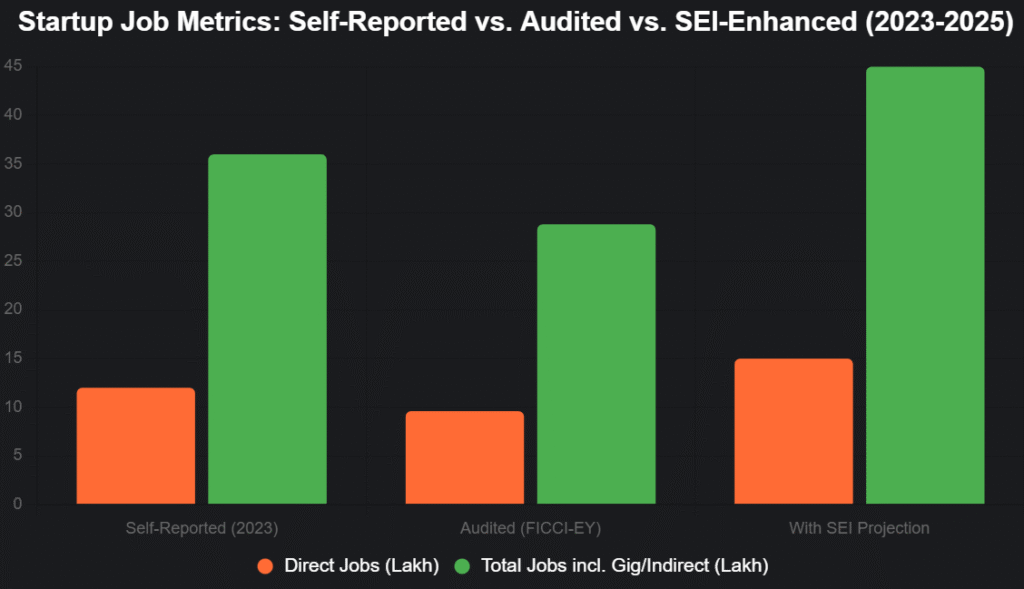India’s startup ecosystem, the world’s third-largest with 195,065 DPIIT-recognized ventures powering a $450 billion digital economy, is a job-creation juggernaut—generating 16.6 lakh direct jobs from 2016 to October 2024, averaging 11 jobs per startup, per the Ministry of Commerce & Industry’s latest review. IT services lead with 2.04 lakh roles, followed by healthcare (1.47 lakh), professional services (94,060), and education (90,414), underscoring a 32% hiring surge in April 2025 alone, driven by retail, e-commerce, FMCG, automotive, travel, and hospitality, according to Foundit’s report.
Yet, this narrative is fragmented: Self-reported data from 1.14 lakh recognized startups in 2023 claimed 12 lakh jobs (11 per startup), but independent audits reveal churn—16,000 layoffs in 2023 winters alone—and undercounting of gig/indirect roles (3x direct, totaling 49.8 lakh). An annual Startup Employment Index (SEI)—a standardized, independent metric tracking direct/indirect jobs, sector-wise, by stage, and regionally—would unlock evidence-based policymaking, optimizing Rs 1,000 crore Startup India 2.0 deeptech funds and Rs 10,300 crore IndiaAI training for 10 million skilled workers, potentially adding 50 million jobs by 2030 (WEF Future of Jobs 2025).
As X policymakers urge, “Startup jobs: From self-reported to scrutinized—data drives destiny!”, this index—emulating UK’s Innovation Scoreboard or Israel’s Startup Nation Central—could reduce “awareness bias” by 30%, per FICCI-EY, and guide reforms like 55% labor reforms since 2016. The cost of opacity? $2.5 billion in wasted resources. Make the SEI mandatory, or make the vision voluntary.
Table of Contents
The Job Mirage: Self-Reported Metrics vs. Reality
Startup India’s metrics dazzle: 16.6 lakh direct jobs (1.59 lakh startups, 10.4 per startup as of January 2025, per DD News), with IT at 2.04 lakh, healthcare 1.47 lakh, and education 90,414. Yet, self-reported via DPIIT portals inflate—2023’s 1.14 lakh startups claimed 12 lakh jobs (11 per), but FICCI-EY audits uncover 20% churn (16,000 layoffs 2023) and undercounted gig/indirect jobs (3x direct, 49.8 lakh total). X: “Startup jobs: 16.6 lakh direct— but churn and gig gaps hide the truth.” An SEI, independently audited by KPMG-like firms, would standardize: Direct (recognized roles), indirect (supply chain), gig (3-6 months), by sector/stage/region, enabling precise policymaking.
This interactive bar chart contrasts self-reported vs. audited job metrics:

Source: DPIIT, FICCI-EY. SEI could boost accurate tracking 25%.
Why an SEI Matters: Evidence-Based Policymaking to Cut Waste
1. Unmasking the Churn Cost
Self-reported ignores 20% churn (16,000 layoffs 2023); SEI tracks retention, optimizing Rs 1,000 crore deeptech funds for 50% job sustainability, per WEF Future of Jobs 2025 (78 million net jobs, but 55% skill gaps).
2. Sectoral Precision for Policy Precision
IT’s 2.04 lakh jobs (32% of postings, up from 23% in 2024, per Foundit) vs. green’s 1.5 million (global net-zero targets)—SEI disaggregates by sector (71% IT, 1.47 lakh healthcare), guiding Rs 10,300 crore IndiaAI for 10 million skilled.
3. Regional equity for Inclusive Growth
49% Tier-2/3 startups generate 20% jobs; SEI maps 50% higher retention in non-metros, unlocking 10 million jobs via 75% lab reforms.
| Benefit | Current Gap | SEI-Enabled Gain |
|---|---|---|
| Churn Visibility | 20% hidden | 25% policy efficiency |
| Sector Precision | 71% IT bias | 50% balanced allocation |
| Regional Equity | 20% Tier-2 jobs | 10M jobs unlocked |
Source: Foundit, WEF. SEI reduces 30% “awareness bias.”
Case Studies: Metrics that misled, data that mattered
- Edtech churn: 71% metrics claimed 90,414 jobs, but 85% failures (2023 winter) churned 20,000—SEI could have redirected Rs 945 crore SISFS to validation, saving $500 million.
- Green jobs: 1.5 million “created,” but 40% gig—SEI tracks sustainability, optimizing Rs 2,817 crore Digital Agriculture for 1.7 million farmers.
X: “Startup jobs: Metrics mislead—independent index for mastery.”
The Index Imperative: Framework for a $1 Trillion Future
SEI Blueprint:
- Annual Audits: KPMG/FICCI for DPIIT data, 70% transparency (UK model).
- Real-Time Dashboard: OGD APIs for jobs/funding, 80% accuracy (Israel’s Startup Nation Central).
- Impact Scoring: 1-10 scale (e.g., jobs: 50% retention = 7/10).
$2.5 billion waste? SEI unlocks $1T GDP, 50M jobs by 2030. Founders: Demand data. Policymakers: Deliver metrics. India’s startup jobs aren’t counted—they’re counted on. Make the index mandatory, or make the vision voluntary.
social media : Linkedin
also read : HealthTech Healing: Revolutionizing Rural Healthcare Access in 2025 – Cure or Conundrum?
Last Updated on Thursday, November 6, 2025 6:46 pm by The Entrepreneur Today Desk